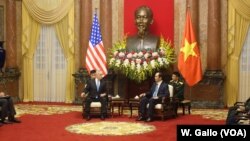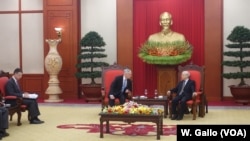A high-level U.S. visit to Vietnam followed by plans to send American naval vessels may herald a tougher American policy toward China in Asia's stickiest maritime sovereignty dispute.
U.S. Defense Secretary James Mattis met in Vietnam last week with the host country’s president, Tran Dai Quang, as well as the general secretary of its ruling Communist Party and a Vietnamese military counterpart.
The U.S. Department of Defense website said they shared concerns about freedom of navigation and “respect for international law,” likely references to a six-way dispute over sovereignty of the South China Sea dominated by Beijing. A U.S. aircraft carrier will call in Vietnam in March. Vietnam is the most outspoken rival claimant to China.
“The Mattis visit and the one by the aircraft carrier in March are intended to send a signal to China about its assertive behavior in the South China Sea,” said Murray Hiebert, deputy director of the Southeast Asia Program at the Center for Strategic and International Studies in Washington.
“The visits are part of a series of steps by Vietnam and the United States in recent years to bolster their political and security ties as China rises and steps up its activities in the South China Sea,” he said.
An extension of military ties with Vietnam would mark President Donald Trump’s strongest stance on the South China Sea dispute to date following a year of doubt about whether he would challenge the dominance of Beijing in favor of five other governments that contest Chinese claims.
China’s maritime rise
Brunei, Malaysia, the Philippines, Taiwan and Vietnam vie for control over all or parts of the 3.5 million-square-kilometer sea between Hong Kong and Borneo. They resent passage of Beijing’s coast guard vessels and its landfilling of small islets for military installations, hallmarks of growing maritime control by Asia’s chief military power.
China claims about 90 percent of the sea. It cites historical records to document the claims. In mid-2016 a world arbitration court ruled at the request of the Philippines against the extent of the Chinese claim. China rejected the ruling but since then made peace with other claimants by offering aid, investment and joint marine research.
Over the past year, China also built up three islets in the sea’s Spratly archipelago and three more in the Paracel chain, according to the Center for Strategic and International Studies’ Asia Maritime Transparency Initiative. Vietnam says the Paracels fall under its flag.
“I think that maybe China is not happy with the U.S. visit, but they have to accept the facts that Vietnam is becoming a big player in the region and Vietnam has its own freedom in maintaining (a) better relationship with the U.S.,” said Trung Nguyen, international relations dean at Ho Chi Minh University of Social Sciences and Humanities.
Expectations for Trump
Southeast Asian countries with claims to the sea waited in 2017 for Trump to form a clear South China Sea policy.
Trump spent much of the year seeking Beijing’s help containing weapons development in North Korea, muting any challenges to Chinese maritime activities. The U.S. Navy, however, passed ships through the disputed sea four times in 2017 and once this month to show its position that the waterway is free to all.
But Trump did not pick up his predecessor Barack Obama’s policy of arms sales and joint military training for Southeast Asian maritime claimants.
The Philippines befriended Beijing in late 2016. China is helping the country build railways, resist armed Muslim extremists and explore an undersea plateau off the Philippine Pacific coast. Philippine President Rodrigo Duterte began in 2016 pushing back against the United States, a former colonizer and staunch military ally since the 1950s.
Malaysia also counts China as its top investor and trading partner, likewise a source of new infrastructure. Trump toyed with stronger Taiwan ties a year ago but stopped after a protest from Beijing, which claims Taiwan as its own.
Mattis’ Vietnam visit this month augurs a “tougher line on Beijing in general” in Washington, said Sean King, vice president of the Park Strategies consultancy in New York. The shift might come too late, he said.
“Relations with Vietnam are now more vital than ever as we appear to have already lost the Philippines on the South China Sea,” King said. “It may all be too late as Beijing’s hold on the South China Sea appears to have entered fait accompli territory.”
Arms sales
Improved ties could lead Vietnam to buy military hardware from the United States, Hiebert said. In 2016, Obama lifted a decades-old ban on sales of lethal weapons to the Communist country that the United States fought in the 1960's and 1970's. Vietnam has clashed before at sea with China, which is militarily stronger.
Vietnam ranked the world’s eighth largest importer of weapons from 2011 to 2015, up from 43rd in the previous five years, said Carl Thayer, emeritus professor with the University of New South Wales in Australia. Vietnam is looking now for a fighter jet to replace its Russian-made MiG-21 fleet that it retired over a year ago, he said.
Vietnam acquired a former U.S. coast guard cutter in December, according to the the U.S. defense department website.
But officials in Hanoi are expected to move slowly toward warmth in U.S. relations. They value ties with China, too, as neighbors and trade partners. “I’m sure Vietnamese leaders know they will not walk so fast toward improving relationships with the U.S.,” Nguyen said.












